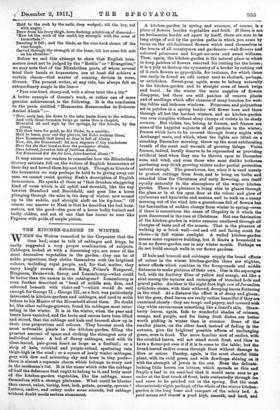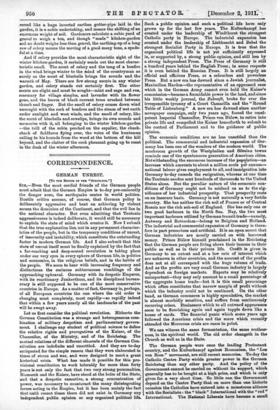THE KITCHEN-GARDEN IN WINTER.
WHEN the Walrus remarked to the Carpenter that the time had come to talk of cabbages and kings, he really suggested a very proper combination of subjects. Cabbages, looked at with a discerning eye, are some of the most decorative vegetables in the garden : they can be of noble proportions, they clothe themselves with the brightest colours, including royal purple, and, for that matter, they carry kingly names. Autumn King, Prince's Nonpareil, Braganza, Brunswick, Savoy, and Luxembourg—what could be better than the names in the catalogues P Luxembourg is even further described as "head of middle size, firm, and coloured beneath with violet-red "—which would do well enough for George II. ; George III., as a fact, was particularly interested in kitchen-gardens and cabbages, and used to write letters to his Master of the Household about them. No doubt he, like other cabbage-growers, found his cabbages most inter- esting in the winter. It is in the winter, when the peas and beans have vanished, and the beets and onions have been lifted and stored, that the cabbage and kale and broccoli show up in their true proportions and colours. They become much the most noticeable plants in the kitchen-garden, filling the greatest amount of space and striking the strongest note of individual colour. A bed of Savoy cabbages, each with its close-leaved, pale-green heart as large as a football; or a strip of kale, crinkled and purple-veined, spattering rain thigh-high in the wind ; or a square of lowly winter cabbages, grey with dew and mirroring sky and trees in tiny pools— there is almost a separate charm which belongs to every sort in the seedeman's list. It is the name which robs the cabbage of half the deference that ought to belong to it, and truly most of the kitchen-garden vegetables, like the cabbage, name themselves with a strange plainness. What could be blunter than carrot, onion, turnip, beet, leek, potato, parsnip, sprouts ? Lettuce, endive, and celery make some amends, but cabbage without doubt needs serious atonement. A kitchen-garden in spring and summer, of course, is a place of flowers besides vegetables and fruit. If there is not an herbaceous border set apart by itself, there are sure to be long strips of soil by the garden paths in which you come by turns on the old-fashioned flowers which seed themselves in the hearts of all countrymen and gardeners—wall-flowers and coloured primroses and forget-me-nots and sweet williams. Then, again, the kitchen-garden is the natural place in whieh to keep patches of flowers reserved for cutting for the house; it is a pity to destroy the symmetry of a border by cutting out of it such flowers as gypsophila, for instance, for which there can easily be found an odd corner next to rhubarb, perhaps, or artichokes. Sweet-peas, again, seem to belong naturally to the kitchen-garden and to straight rows of beech twigs and hazel. In the winter the main supplies of flowers disappear, but there are still patches of reserve plants and of seedlings which offer chances of stray bunches for writ- ing-tables and bedroom windows. Primroses and polyanthus set in patches in a spring border will flower here and there through all but the hardest winters, and no kitchen-garden was ever complete without stray clumps of violets in its shady corners. But violets, too, belong to frames, and frames are some of the happiest aujuncts of all gardens in the winter; frames which have to be covered through frosty nights with Archangel mats, and which, when the lights are lifted on a sunshiny December morning, throw up the most exhilarating breath of the scent and warmth of growing things. Violet frames, indeed, hardly deserve to be reproached as providing artificial heat when they can be thrown open to December suns and wind, and even those who most dislike hothouse gardening may think growing violets under partial protection natural enough. The greenhouse, too, when it is used merely to protect cuttings from frost, and to bring on bulbs and retarded lilies for Christmas and early flowering, sets itself equally naturally in the atmosphere of the winter kitchen garden. There is a pleasure in being able to glance through the glass or in at the open door at the colour and glow of cyclamens and hyacinths and azaleas, and to walk on a sunny morning out of the wind into a greenhouse full of flowers has the fascination of sudden change from winter to spring—even if there is somewhere the sense of illegality in it which the poet discovered in the rose at Christmas. But one fascination of the kitchen-garden in winter remains unaltered through all changes of taste and of the season. That is the pleasure of walking by a brick wall—red and old and facing south for choice—in full winter sunlight. A walled kitchen-garden means some expensive building, but it draws a household to it as no flower-garden can in any winter month. Perhaps we do not build enough walls in our flower gardens.
If kale and broccoli and cabbages supply the broad effects of colour in the winter kitchen-garden there are slighter, minor effects which combine in the foregrounds and middle distances to make pictures of their own. One is the asparagus bed, with its feathery films of yellow and orange, set like a mist among the squares and rectangles of trenched beds and gravel paths. Another is the eight-foot-high row of Jerusalem artichoke stems, with their withered, drooping leaves fluttering in the wind. At a distance the effect is of decay and gloom; but the grey, dead leaves are really rather beautiful if they are examined closely : they are tough and papery, and covered with tiny white excrescences something like a lizard's skin. Straw- berry leaves, again, fade to wonderful shades of crimson, orange, and purple, and for lining fruit dishes are better worth picking in winter than in summer. Some of the smaller plants, on the other hand, instead of fading in the autumn, give the brightest possible effects of unchanging green, even in frost. The more familiar sort of endive, with the crinkled leaves, will not stand much frost, and likes to have a flower-pot over it if it is to come to the table ; but the broad-leaved endive comes through frost without damage to fibre or colour. Parsley, again, is the most cheerful little plant, with its vivid green and with dewdrops shining on it with the strength of jewels in the sun. Even the delicate- looking little brown cos lettuce, which spreads so thin and fragile a leaf in its seed-bed that it would seem sure to go under at the first touch of frost, lasts contentedly through ice and snow to be pricked out in the spring. But the most characteristic sight, perhaps, of the whole of the winter kitchen- garden is the long fosse and rampart of the celery bed. A yard across grid ulraost a yard high, smooth, and hard, and
round like a huge inverted earthen gutter-pipe laid in the garden, it is a noble undertaking, and means the shifting of an enormous weight of soil. Gardeners calculate a cubic yard of gravel to weigh a ton, and though "made" kitchen-garden soil no doubt weighs less than gravel, the earthing-up of a long row of celery means the moving of a good many tons, a spade- ful at a time.
And if celery provides the most characteristic sight of the winter kitchen-garden, it certainly sends out the most charac- teristic swell. The scent of celery and the tang of a bonfire in the wind brings winter to the mind of the countryman as surely as the scent of bluebells brings the sounds and the warmth of May. There are few strong scents in any winter garden, and celery stands out certainly first. The other scents are slight and must be sought—mint and sage and rue, rosemary for village simples, and lavender with its flower gone, and the leaves of black currant trees crushed between thumb and finger. But the smell of celery comes down wind unsought with the reek of bonfires and the steam of wet earth under sunlight and west winds, and the smell of celery, like the scent of bluebells and cowslips, brings its own sounds and memories with it, all belonging to the winter kitchen-garden —the trill of the robin perched on the espalier, the chack- chack of fieldfares flying over, the voice of the huntsman calling to his hounds from the wood at the bottom of the hill beyond, and the clatter of the cock pheasant going up to roost in the dusk of the winter afternoon.



































































 Previous page
Previous page